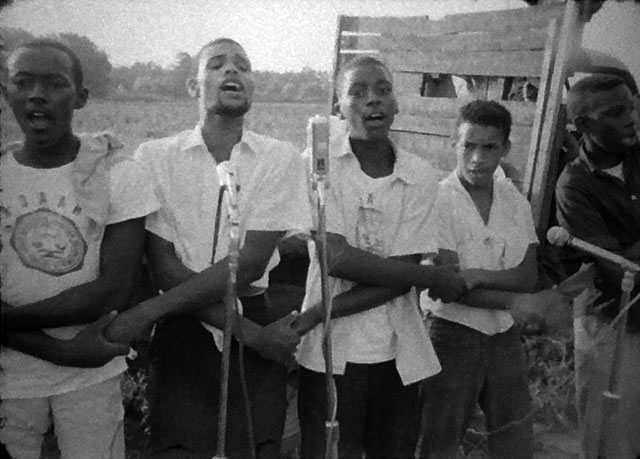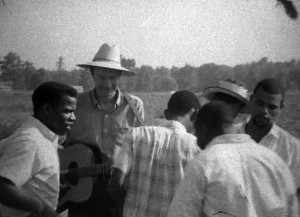The Fight for Rights on The Streets of Greenwood
In their 1963 documentary The Streets of Greenwood, a group of young film-makers provided a close-up view of a Mississippi voter-registration drive, of citizens claiming their basic rights, and of a rally that lifted the spirits of harassed activists.

At the beginning of its rare historic footage, the 1963 film The Streets of Greenwood depicts activists and protesters joining together in rural Mississippi to oppose the cruel, demeaning conditions imposed on share croppers for many decades by white landowners and their allies among police officers, the political hierarchy, and the white population generally.
The protesters are there to celebrate their halting progress towards a new day. From buses and along roadways, they gather to sing in the cotton fields and, with the assistance of activists including Bob Moses, to register to vote for the first time.
There to capture the proceedings in July 1963 were three young film makers, Jack Willis, John Reavis, and Fred Wardenburg, and cameraman Ed Emshwiller, and their film stands as a rare document of the era’s quest for the most basic conditions of social justice. One month after the Greenwood rally, civil-rights leaders would launch the historic March on Washington.
In its brief 20 minutes, The Streets of Greenwood records voter-registration efforts in Greenwood during a particularly dangerous phase of the civil-rights movement. For journalist, film maker, and producer Jack Willis, Streets of Greenwood was his first venture in film; it won the gold medal at the San Francisco Film Festival, and would lead to his directing, producing, or writing 16 more documentaries and several television series. His films include Paul Jacobs and the Nuclear Gang (1979), a damning multi-award-winning exposé of government suppression of the health hazards of exposure to radiation from Nevada nuclear testing during the 1950s and 1960s.
The National Film Preservation Foundation has recently awarded funds to Washington University’s Film & Media Archive to preserve The Streets of Greenwood along with two reels of outtakes. In its 2016 round of preservation grants, NFPF provided funding to 39 institutions to restore 64 films and make them publicly accessible. In 1996, the U.S. Congress created NFPF to help save America’s film heritage. The Foundation receives federal money through the U.S. Library of Congress. It has to date provided preservation support to 284 institutions and saved almost 2,300 films.
The Streets of Greenwood is relatively obscure by comparison with some other films documenting the civil-rights era. But its enormous historical significance and educational value lie in its close-up view of the efforts of activists to register African American voters in Greenwood, Mississippi. Over the years, Willis has often licensed material from it, most recently for “The Voting Rights Act at 50,” an event held by the Smithsonian Institution and the NAACP in July 2015. It has been used in a variety of other films about the civil-rights era, including works by noted African American filmmakers Stanley Nelson and Sam Pollard.
Cameraman Ed Emshwiller used Seeger’s Auricon camera to document the event, while Willis was inspired in his direction by the handheld-camera approach of the Drew Unit. That was a group of cameramen and correspondents whom Life magazine photojournalist and editor Robert Drew assembled in the 1950s — including the later high-profile filmmakers Richard Leacock, D.A. Pennebaker, and Albert Maysles — to produce films that revolutionized documentary filmmaking in the United States by introducing the cinéma vérité observational approach to capturing everyday life.
Willis donated his two prints of The Streets of Greenwood to Washington University’s Archive, and told archivists there that he knew of no earlier elements of the film. The Archive will preserve the longer, more complete of the two prints, which runs to 725 feet of 16mm film. Archivists at the St. Louis, Missouri, institution found records of six other prints, around the world, but none are the filmmakers’ personal prints, and none include the two reels of outtakes, which Willis also donated.
The film is, then, not widely available. No commercial DVDs or other for-profit distribution exists, although Willis has made available on Vimeo a low-resolution version.
Washington U archivists will make new prints from, in the case of the film itself, 725 feet of acetate, 16mm, black & white Kodak composite print stock, and in the case of the outtakes, from another 1,525 feet of the same kind of film. The prints they will work from exhibit shrinkage — a common issue in restoration projects — but not severely in the case of the film prints, and moderate in the case of the outtakes.
Archivists will make copies of the prints’ video and audio components and then composite prints that will serve as the basis for distributable prints as well as a high-definition digital preservation file and Blu-Ray access copies.
All that bodes well for the events that Willis and his colleagues filmed. They made Streets of Greenwood after Willis and James Forman, a visionary activist and early key member of SNCC, fell into conversation with singer Pete Seeger about the Student Nonviolent Coordinating Committee’s efforts to get black Mississippians onto electoral rolls.
SNCC had for a year been organizing in difficult circumstances in and around Greenwood. Police had responded to their peaceful protests with arrests and dog attacks. One leading civil-rights activist, Medgar Evers, had been murdered in June 1963; the killer, Byron de La Beckwith, a white supremacist and Ku Klux Klan member who lived in Greenwood, would not be convicted until 1994 because in 1964 two juries declined to find him guilty.
SNCC activists pressed on, and called a July 1963 rally and concert. Performers who agreed to appear included Bob Dylan along with two figures in the “protest song” movement, Seeger and Theodore Bikel, who in 1959 had started the Newport Folk Festival in the northeast state of Rhode Island, five years after the city’s annual jazz festival had begun. (Emshwiller captured footage of Bob Dylan singing “Only a Pawn in Their Game,” which is about the assassination of Medgar Evers, at a rally in support of the voter-registration campaign, but it did not appear in The Streets of Greenwood; D.A. Pennebaker used it in his 1967 Dylan documentary, Dont Look Back; Pennebaker traded Willis for it: in return for the use of Pennebaker’s editing room, Willis gave Pennebaker the footage of Dylan singing in Greenwood, and Pennebaker slotted it straight into his portrait of the singer, using exactly what Willis and his colleagues had shot, with no edits.)
Streets of Greenwood includes unsettling interviews in which segregationists including the town’s mayor, a tenant farmer, and white supremacists at a rally of their own vent their gall at mounting local resistance to the political and social status quo. In many respects, the footage serves to illustrate thinking of the time. Language in it often reflects white-activist paternalism – talk of “the new Negro discontent.” At other times, it demonstrates the staggering condescension of the white land-owners and townspeople: the self-congratulating “good white folks” who speak of their affection for the “real good nigger” and the true supremacist bigots who spew blood-curdling venom.
In stark contrast, black citizens tell of the oppressive nature of the share-cropping system of agriculture with which Southern land owners had sought to extend their control of economic production after the Civil War and abolition of slavery a century earlier.

Singer and activist Pete Seeger among the organizers of the Greenwood voter-registration drive. This image and one above: Washington University Film & Media Archive.
Interspersed is footage of performances by Seeger joining activists in singing protest anthems of the day, including “Keep Your Eyes on the Prize.” The outtake material includes additional sequences of Seeger and Bikel, as well as as-yet unreleased footage from the freedom rally: protesters gathering, singing, and linking hands.
Jack Willis donated The Streets of Greenwood to Washington University, retaining the rights until his death. (Willis will continue to license the footage, while he lives, and the Archive will supply the footage to people, once he approves their use.) At the Film & Media Archive it joins some 6,500,000 feet of film, 1,300 linear feet of manuscripts, nearly 20,000 videotapes, over 10,000 audiotapes and reels, and a significant library of books, CDs and DVDs. Under the terms of the gift, the Archive will make the restored film readily available for educational screenings, and license footage for use in documentaries and the like.
The Film & Media Archive will place the restoration and the outtakes on digital display at its facilities, and will make a digital, streaming version available via its soon-to-be-completed, unrestricted online media repository.
Among the Archive’s plans for public presentation are to screen the film at a campus and online exhibition featuring oral-history audio clips about the film with Jack Willis, now co-founder of Link TV, a Direct Broadcast Satellite channel that goes to more than 34 million American homes, along with film, photographs, and other material from the Archive’s Henry Hampton Collection.
Previous Post: Joel Archer's Quest for Film Revival
Next Post: Nitrate Film Makes A Comeback





